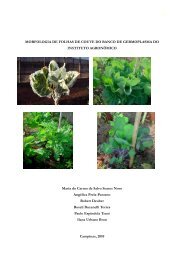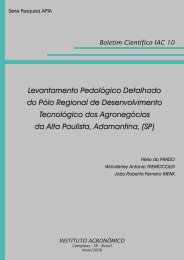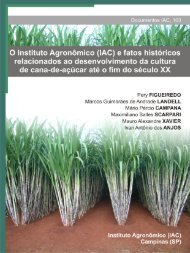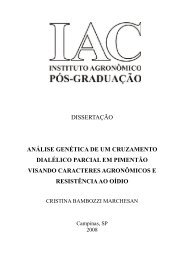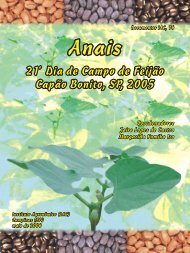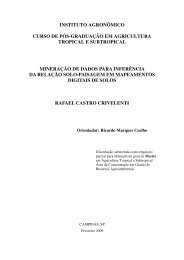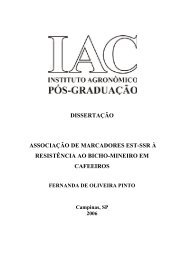vi seminário sobre pragas, doenças e plantas daninhas do ... - IAC
vi seminário sobre pragas, doenças e plantas daninhas do ... - IAC
vi seminário sobre pragas, doenças e plantas daninhas do ... - IAC
- No tags were found...
Create successful ePaper yourself
Turn your PDF publications into a flip-book with our unique Google optimized e-Paper software.
ABSTRACT<br />
CONTROL OF BEAN WHITE MOLD WITH FUNGICIDE AND CULTURAL METHODS . White mold on<br />
common beans has increased in the last years in Brazil. No single treatment pro<strong>vi</strong>des a satisfactory<br />
disease management. The objective of this work was to study the association of control strategies in a S.<br />
sclerotiorum naturally infested field. Three experiments were carried out on May-August 2004 and 2005.<br />
The 2004 trials were conducted as a 2 x 2 x 3 factorial in the ran<strong>do</strong>mized complete-block design: two<br />
irrigation frequencies (seven und 14 days), two plant densities (rows spaced 0.5 m apart with 6 or 12<br />
plants/m), three disease control treatments (no control, fluazinam, Trichoderma spp.), with four replications.<br />
The 2005 trial was conducted as a 2 x 2 x 3 factorial with two irrigation frequencies, two sowing systems<br />
(conventional and no-tillage), three disease control treatments (no control, fluazinam, Trichoderma harzianum),<br />
with four replications. No significantly effect of irrigation frequencies was observed either on disease<br />
development or on bean yield, probably due the untypical rain occurred during the experiments. Higher<br />
disease severity was observed with 12 plants/m compared to 6 plants/m. Some yield components were<br />
higher with 6 plants/m compared to 12 plants/m. Disease intensity was similar in both sowing systems<br />
tested. Fluazinam was efficient to control the disease and to improve the bean yield compared to treatments<br />
with no application of fungicide and application of Trichoderma spp.<br />
Key words: Phaseolus vulgaris, Sclerotinia sclerotiorum, Trichoderma, integrated control.<br />
1. INTRODUÇÃO<br />
O mofo-branco <strong>do</strong> feijoeiro (Sclerotinia sclerotiorum) tem si<strong>do</strong> a principal <strong>do</strong>ença da cultura<br />
em áreas irrigadas, especialmente no outono-inverno. Medidas isoladas não são eficientes no controle<br />
da <strong>do</strong>ença, quan<strong>do</strong> comparadas ao uso de práticas usadas de maneira simultânea. A aplicação de<br />
fungicidas tem si<strong>do</strong> recomendada em campos onde a <strong>do</strong>ença já se instalou. Apesar de haver produtos<br />
que, comprovadamente, reduzem a intensidade da <strong>do</strong>ença, o controle químico é caro e os riscos de<br />
contaminação <strong>do</strong> ambiente são altos. Ademais, como medida isolada, o controle químico pode ter<br />
eficiência baixa, o que torna obrigatória a utilização de outras medidas, inclusive para aumentar a<br />
sua eficiência. Existem várias práticas culturais que contribuem para a redução <strong>do</strong> inóculo <strong>do</strong> patógeno<br />
e da <strong>do</strong>ença (PAULA JR. et al., 2006). O objetivo deste trabalho foi estudar a associação de estratégias<br />
de controle <strong>do</strong> mofo-branco <strong>do</strong> feijoeiro em área irrigada, incluin<strong>do</strong> controle biológico, plantio direto,<br />
redução da freqüência de irrigação e da densidade de plantio e aplicação de fungicida.<br />
2. MATERIAL E MÉTODOS<br />
Os experimentos foram realiza<strong>do</strong>s em área naturalmente infestada com escleródios de S.<br />
sclerotiorum, em duas safras de outono-inverno. Em <strong>do</strong>is experimentos conduzi<strong>do</strong>s de maio a agosto<br />
de 2004, foi monta<strong>do</strong> um fatorial 2 x 2 x 3, com <strong>do</strong>is regimes de irrigação (semanal e quinzenal),<br />
duas densidades de plantio (6 e 12 sementes/m), três estratégias de aplicação (fungicida fluazinam,<br />
Trichoderma spp. e testemunha sem aplicação). No experimento de 2005, o fatorial 2 x 2 x 3 consistiu<br />
de <strong>do</strong>is regimes de irrigação (duas vezes por semana e quinzenal), <strong>do</strong>is sistemas de plantio<br />
Documentos, <strong>IAC</strong>, Campinas, 79, 2007<br />
125




